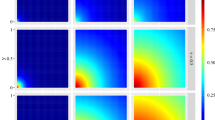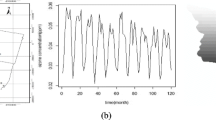Abstract
A new method based on distances for modeling continuous random data in Gaussian random fields is presented. In non-stationary cases in which a trend or drift is present, dealing with information in regionalized mixed variables (including categorical, discrete and continuous variables) is common in geosciences and environmental sciences. The proposed distance-based method is used in a geostatistical model to estimate the trend and the covariance structure, which are key features in interpolation and monitoring problems. This strategy takes full advantage of the information at hand due to the relationship between observations, by using a spectral decomposition of a selected distance and the corresponding principal coordinates. Unconditional simulations are performed to validate the efficiency of the proposed method under a variety of scenarios, and the results show a statistical gain when compared with a more traditional detrending method. Finally, our method is illustrated with two applications: earth’s average daily temperatures in Croatia, and calcium concentration measured at a depth of 0–20 cm in Brazil.
Supplementary materials accompanying this paper appear online.








Similar content being viewed by others
Notes
The intamap library of R was used (Pebesma et al. 2010), which gave an angle of − 70.11126 and a rate of 1.141188.
\(|N(h_j)|\) was considered for the weights.
References
Armstrong, M. and Diamond, P. (1984), ‘Testing variograms for positive-definiteness’, Mathematical Geology16, 407–421.
Bardossy, A., Haberlandt, U. and Grimm-Strele, J. (1997), Interpolation of groundwater quality parameters using additional information, Technical report, In GeoENV I (Geostatistics for Environmental Applications), 189-200, Kluwer Academic Publ., Dordrecht.
Bivand, R., Pebesma, E. and Rubio, V. (2008), Applied Spatial Data Analysis with R, Springer, New York.
Capeche, C. L., Macedo, J. R., Manzatto, H. R. H. and Silva, E. F. (1997), Caracterização pedológica da fazenda angra - pesagro/rio, Technical report, Technical Report: Estação experimental de Campos (RJ). In Informação, globalização, uso do solo, Rio de Janeiro.
Cressie, N. (1993), Statistics for Spatial Data, Revised Edition. John Wiley & Sons Inc., New York.
Cressie, N. and Hawkins, D. M. (1980), ‘Robust estimation of the variogram: I’, Mathematical Geology12(2), 115–125.
Cuadras, C. M., Arenas, C. and Fortiana, J. (1996), ‘Some computational aspects of a distance-based model for prediction’, Communications in Statistics - Simulation and Computation25(3), 593–609.
Cuadras, C. M. (1989), Distance analysis in discrimination and classification using both continuous and categorical variables., in Y. Dodge, ed., ‘Statistical Data Analysis and Inference’, Amsterdam: North-Holland Publishing Co., pp. 459–473.
Cuadras, C. M. (1993), ‘Interpreting an inequality in multiple regression’, The American Statistician47(4), 256–258.
Cuadras, C. M. and Arenas, C. (1990), ‘A distance based regression model for prediction with mixed data’, Communications in Statistics A - Theory and Methods19, 2261–2279.
Gower, J. (1968), ‘Adding a point to vector diagrams in multivariate analysis’, Biometrika55, 582–585.
Gower, J. (1971), ‘A general coefficient of similarity and some of its properties’, Biometrics27, 857–871.
Hengl, T. (2009), A Practical Guide to Geostatistical Mapping, 2nd edn, University of Amsterdam, Amsterdam.
Jin, R., Chen, W. and Simpson, T. (2001), ‘Comparative studies of metamodeling techniques under multiple modeling criteria’, Journal of Structural & Multidisciplinary Optimization23, 1–13.
Joseph, V. R., Hung, Y. and Sudjianto, A. (2008), ‘Blind kriging: A new method for developing metamodels.’, Journal of Mechanical Design3, 31–102.
Le, N. and Zidek, J. (2006), Statistical Analysis of Environmental Space-Time Processes, Springer, .
Mardia, K. V., Kent, J. T. and Bibby, J. M. (2002), Multivariate Analysis, Academic Press, Inc, London.
Melo, C., Santacruz, A. and Melo, O. (2012), geospt: An R package for spatial statistics. R package version 1.0-0. http://geospt.r-forge.r-project.org/
Pebesma, E.and Cornford, D., Dubois, G., Heuvelink, G. B. M., Hristopoulos, D., Pilz, J., Stoehlker, U., Morin, G. and Skoien, J. O. (2010), ‘Intamap: the design and implementation of an interoperable automated interpolation web service’, Computers & Geosciences37, 343–352. https://doi.org/10.1016/j.cageo.2010.03.019
Perčec-Tadić, M. (2010), ‘Gridded croatian climatology for 1961-1990’, Theoretical and Applied Climatology pp. 1434–4483.
Sacks, J., Welch, W., Mitchell, T. J. and Wynn, H. P. (1989), ‘Design and analysis of computer experiments’, Statistical Science4, 409–423.
Santner, T., Williams, B. and Notz, W. (2003), The Design and Analysis of Computer Experiments, Springer-Verlag, New York.
Sokal, R. R. and Michener, C. D. (1958), ‘A statistical methods for evaluating relationships’, University of Kansas Science Bulletin38, 1409–1448.
van de Kassteele, J., Stein, A., Dekkers, A. and Velders, G. (2009), ‘External drift kriging of NOx; concentrations with dispersion model output in a reduced air quality monitoring network’, Environmental and Ecological Statistics16, 321–339.
Wackernagel, H. (2003), Multivariate Geostatistics: An Introduction with applications, Third Completely Revised Edition. Springer-Verlag, New York.
Zaninovic, K., Gajic-Capka, M. and Perčec-Tadić, M. (2008), Klimatski atlas Hrvatske, climate altas of Croatia 1961, 1990, 1971 2000., Technical report, Meteorological and Hydrological Service Republic of Croatia, Zagreb.
Acknowledgements
Work partially funded and supported by: Grant MTM2016-78917-R from the Spanish Ministry of Science and Education, Core Spatial Data Research (Faculty of Engineering, COL0013969, Universidad Distrital Francisco José de Caldas), and Applied Statistics in Experimental Research, Industry and Biotechnology (COL0004469, Universidad Nacional de Colombia). The authors are grateful to the AE and the referees for their helpful comments and suggestions that have improved the manuscript.
Author information
Authors and Affiliations
Corresponding author
Additional information
Publisher's Note
Springer Nature remains neutral with regard to jurisdictional claims in published maps and institutional affiliations.
Electronic supplementary material
Below is the link to the electronic supplementary material.
Rights and permissions
About this article
Cite this article
Melo, C.E., Mateu, J. & Melo, O.O. A Distance-based Method for Spatial Prediction in the Presence of Trend. JABES 25, 315–338 (2020). https://doi.org/10.1007/s13253-020-00395-2
Received:
Accepted:
Published:
Issue Date:
DOI: https://doi.org/10.1007/s13253-020-00395-2




